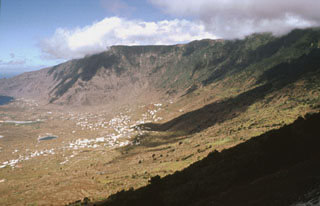Report on Hierro (Spain) — 9 November-15 November 2011
Smithsonian Institution / US Geological Survey
Weekly Volcanic Activity Report, 9 November-15 November 2011
Managing Editor: Sally Sennert.
Please cite this report as:
Global Volcanism Program, 2011. Report on Hierro (Spain) (Sennert, S, ed.). Weekly Volcanic Activity Report, 9 November-15 November 2011. Smithsonian Institution and US Geological Survey.
Hierro
Spain
27.73°N, 18.03°W; summit elev. 1500 m
All times are local (unless otherwise noted)
Instituto Geográfico Nacional (IGN) reported that during 9-15 November the submarine eruption continued S of El Hierro Island; mean amplitude of tremor was similar to that of the previous week. During the period, 245 seismic events were recorded, most of them located offshore to the N of the island, at depths of 16-23 km. Twenty one of these events were felt by residents at a maximum intensity value of IV-V using EMS-98 (European Macroseismic Scale). The maximum magnitude was 4.6, for an event located 2.5 km offshore to the N at 21 km depth on 11 November, and was the largest of the 11,604 total events detected since 16 July. GPS deformation analysis continued to show different behaviors between N and S stations; N stations showed deformations to the N up to the time of the M 4.6 event, when the deformation then changed to S. Stations located in the S showed deformation trends to the N.
On 9 November, access to two creeks (Tacorón and Punta Naos) in the S of the island was prohibited due to the possibility of significant concentration of volcanic gases. On 14 November, residents of La Restinga were allowed to return to their homes. That same day, many big steaming lava blocks (more than 1 m in diameter) were observed over the submarine emission center.
Geological Summary. The triangular island of Hierro is the SW-most and least studied of the Canary Islands. The massive shield volcano is truncated by a large NW-facing escarpment formed as a result of gravitational collapse of El Golfo volcano about 130,000 years ago. The steep-sided scarp towers above a low lava platform bordering 12-km-wide El Golfo Bay, and three other large submarine landslide deposits occur to the SW and SE. Three prominent rifts oriented NW, NE, and S form prominent topographic ridges. The subaerial portion of the volcano consists of flat-lying Quaternary basaltic and trachybasaltic lava flows and tuffs capped by numerous young cinder cones and lava flows. Holocene cones and flows are found both on the outer flanks and in the El Golfo depression. Hierro contains the greatest concentration of young vents in the Canary Islands. Uncertainty surrounds the report of an eruption in 1793. A submarine eruption took place about 2 km SSW off the southern point of the island during 2011-12.

